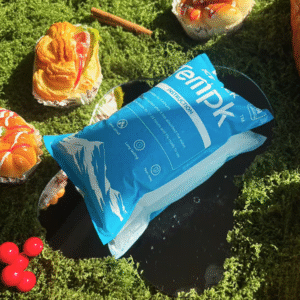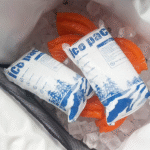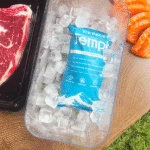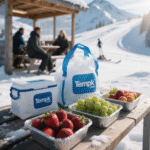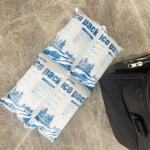Cryogenic dry ice pack sheets are specialized cooling pads that contain solid carbon dioxide (Co₂) locked into flexible cells. When used properly, these sheets maintain temperatures far below freezing, making them ideal for transporting vaccines, mariscos, biological specimens and gourmet foods. Because the CO₂ sublimates (cambia directamente de sólido a gas), dry ice provides intense cold without leaving water residue. This guide answers your most pressing questions about selecting, using and disposing of cryogenic dry ice pack sheets, incorporating the latest 2025 industry data and safety regulations.
What exactly are cryogenic dry ice pack sheets and how do they work?
How to choose the right size and quantity of dry ice pack sheets for different products and transit times
Important safety and regulatory guidelines when shipping with cryogenic dry ice
Benefits and limitations compared with gel packs and phase change materials
Nuevo 2025 innovación, sustainability trends and market insights
Frequently asked questions to help you ship confidently
What Are Cryogenic Dry Ice Pack Sheets?
Cryogenic dry ice pack sheets are flexible pads filled with dry ice particles encased in breathable cells. When exposed to ambient temperatures, the dry ice sublimates (pasa directamente de sólido a gas) at roughly −78.5 °C (-109,3 °F), producing a strong cooling effect without melting Because there is no liquid phase, products stay dry—an important advantage for pharmaceuticals and electronics.
The pack sheets are designed to vent CO₂ gas safely. Traditional dry ice comes in blocks or pellets; pack sheets distribute the carbon dioxide evenly and can be cut to fit any container. They are often paired with insulated boxes or vacuum lined shippers to maintain a stable cryogenic environment.
How Dry Ice Sublimation Works
Dry ice is simply the solid form of carbon dioxide (Co₂). Under normal atmospheric pressure, CO₂ sublimates at –78.5 °C (–109.3 °F). This means that instead of melting into a liquid, it turns directly into a gas. In an insulated environment, the gas remains cold enough to keep products frozen or chilled. The absence of a liquid phase eliminates water damage during transport.
Why Use Cryogenic Dry Ice Pack Sheets?
Reliable Temperature Control for Perishables
Dry ice sheets are widely used in industries such as food shipping, productos farmaceuticos, investigación científica, entertainment and industrial cleaning. Dry ice keeps perishable items like meats, mariscos, frozen desserts and vaccines cold during shipping Because dry ice sublimates without moisture, it prevents the condensation that plagues gel packs or wet ice.
Practical Applications
Conservación de alimentos & Envío – Maintaining extremely low temperatures prevents spoilage and preserves taste and texture Specialty goods like gourmet ice cream or chocolates require a reliably cold environment during transit.
Médico & Transporte Farmacéutico – Vaccines, organs and laboratory reagents are shipped in cryogenic environments to maintain viability Dry ice packs provide non liquid cold that meets stringent regulatory requirements.
Special Effects in Entertainment – Fog and smoke effects are created when dry ice is placed in water, causing rapid sublimation and dense CO₂ fog Dry ice sheets also help simulate snow or clouds on film sets.
Industrial & Scientific Uses – Dry ice blasting propels pellets at high speeds to remove contaminants without chemicals, improving cleaning efficiency and reducing waste Laboratories use dry ice to preserve DNA, tissues and cell cultures at cryogenic temperatures
Benefits Over Conventional Cooling
Sin residuos de agua – Dry ice sublimates directly to gas, leaving no moisture to damage packaging or products.
Lower Temperature Range – Blocks, pellets or pack sheets maintain temperatures down to –78.5 °C, colder than most gel packs which hover around 0 °C.
Compacto & Adjustable – Pack sheets can be trimmed to size, making them versatile for different containers.
Reduced Weight – Dry ice has a high cooling capacity per kilogram, allowing shippers to use less weight compared with gel packs for equivalent cooling.
Determining the Right Amount of Dry Ice Pack Sheets
Choosing the correct quantity of dry ice is essential to maintain product integrity without overspending. Regulations also limit the amount of dry ice per package (a maximum of 200 kg per package according to FedEx’s guidelines).
Factors Affecting Quantity
Product Weight and Density – Heavier products require more cooling capacity.
Duración del tránsito – Longer transit times need more dry ice. A general recommendation is 5–10 libras (2.27–4.54 kg) de hielo seco por 24 horas de transito.
Temperatura ambiente – Shipments traveling through warm climates or during summer months will require extra dry ice.
Calidad de aislamiento – High performance insulated containers reduce the amount of dry ice needed.
Estimating Dry Ice Requirements
The following table—adapted from an industry guide—provides approximate dry ice quantities for various product weights and transit times. These values include extra dry ice to compensate for ambient temperatures.
| Product Weight | 24 hr Transit | 48 hr Transit | 72 hr Transit | Significado práctico |
| 2 lb (0.9 kilos) | 5 lb dry ice | 8 lb dry ice | 10 lb dry ice | Suitable for small vaccine shipments or gourmet chocolates |
| 5 lb (2.3 kilos) | 6 lb dry ice | 9 lb dry ice | 12 lb dry ice | Ideal for frozen meal kits or seafood |
| 10 lb (4.5 kilos) | 10 lb dry ice | 15 lb dry ice | 20 lb dry ice | Useful for bulk meat orders and diagnostic samples |
| 20 lb (9 kilos) | 15 lb dry ice | 22 lb dry ice | 30 lb dry ice | For large laboratory shipments or multiple vaccine vials |
| 50 lb (22.7 kilos) | 20 lb dry ice | 33 lb dry ice | 45 lb dry ice | Large-scale shipments like organ transport or industrial reagents |
Interactive Estimator
Use this simple formula to estimate the weight of dry ice (in pounds) required for your shipment:
dry_ice_weight = product_weight * transit_days * 0.5
Multiply the weight of your product (in pounds) by the number of days in transit.
Multiply the result by 0.5 to obtain a baseline dry ice weight.
Adjust up or down based on insulation quality and ambient conditions.
Ejemplo: A 10 lb shipment traveling for 3 days requires approximately 10 × 3 × 0.5 = 15 libra de hielo seco.
Safety and Regulatory Considerations
Shipping with cryogenic dry ice requires careful adherence to safety regulations. Both the Asociación Internacional de Transporte Aéreo (IATA) y el A NOSOTROS. Departamento de Transporte (PUNTO) classify dry ice as a hazardous material (Y 1845). You must label, mark and package shipments correctly to avoid fines or accidents.
Embalaje & Venting Requirements
FedEx 2025 Dry Ice Job Aid stresses that packages must allow the release of carbon dioxide gas to prevent pressure buildup. It advises against placing dry ice in sealed plastic bags or airtight coolers. En cambio, use high quality fiberboard, plastic or wooden boxes with venting holes. A layer of polystyrene foam works well as insulation, but it must not be sealed airtight. Para grandes cantidades, the maximum dry ice per package is 200 kilos.
Proper Marking and Labeling
According to the Pace University fact sheet:
Gas venting: Packages must include venting systems; nunca selle el hielo seco en recipientes herméticos.
Package integrity: Boxes must withstand loading and unloading stresses, protecting contents from vibration and environmental changes.
Package materials: Avoid plastics that become brittle at low temperatures; use containers specifically designed for dry ice.
Airbill: The air waybill must state “Dry ice, 9, UN 1845” and specify the net weight of dry ice.
Marcas: Mark packages with the name and address of both the shipper and recipient and net quantity of dry ice in kilograms.
Etiquetado: Apply a Class 9 hazard label on two sides of the box and include UN 1845 y peso neto.
Capacitación & Proceso de dar un título
Employees preparing dry ice shipments must be trained under Dangerous Goods regulations. FedEx offers training seminars and notes that shipments to Alaska, Hawaii or international destinations may face service limitations.
Safety Hazards and Best Practices
Handle with protective gear: Dry ice’s extreme cold can cause frostbite. Always use insulated gloves and safety goggles Avoid direct skin contact
Use in well ventilated spaces: CO₂ gas buildup in enclosed areas can displace oxygen and lead to asphyxiation Work in ventilated rooms or outdoors.
Use ventilated containers: Do not store dry ice in airtight refrigerators or freezers; pressure buildup can lead to explosions Choose containers designed for venting
Never ingest dry ice: Even small pieces can cause internal injuries
Label containers: Clearly label packages with hazard warnings and handling instructions to alert handlers
Educate personnel: Provide training on proper handling, emergency response and disposal
Dispose of safely: Let dry ice sublimate in a well ventilated area. Do not dispose of it in sinks or drains, as extreme cold can damage plumbing
Additional Hazards
Explosion hazard: Sealed containers can explode from CO₂ pressure buildup
Chemical burns: Contact may damage plastics or rubber
Transportation hazard: Poorly insulated containers or inadequate ventilation can lead to gas buildup and asphyxiation
Understanding and mitigating these hazards is essential for safe shipping.
Comparing Cryogenic Dry Ice Pack Sheets to Gel Packs and Phase Change Materials
When choosing between cooling media, it’s important to consider temperature ranges, moisture control and cost. Dry ice offers far colder temperatures (–78,5 ºC) compared with gel packs (0 °C to –18 °C). It sublimates without moisture, making it ideal for items damaged by condensation. paquetes de gel, sin embargo, provide gentler cold and are reusable. Materiales de cambio de fase (PCM) can maintain precise temperatures (p.ej., +2 °C a +8 °C) but are more expensive.
| Medio de enfriamiento | Rango de temperatura | Riesgo de humedad | Mejor para | Consideraciones |
| Cryogenic Dry Ice Sheets | Down to –78.5 °C | Ninguno (sublimate al gas) | Envío de productos congelados, vacunas, helado | Requires special packaging and handling; hazardous material regulations apply. |
| Paquetes de gel | 0 °C to –18 °C | Moderado (melts to liquid) | Artículos fríos, short haul shipments | Reutilizable; risk of leaks; not suitable for deep freezing. |
| Materiales de cambio de fase (PCM) | Costumbre (p.ej., +2 °C a +8 °C) | Bajo (encapsulated) | Biological samples requiring strict temperature ranges | Más caro; requires pre conditioning at target temperature. |
Latest Trends and Innovations in Cryogenic Dry Ice Packaging (2025)
Growth of the Insulated Shipping Boxes Market
A 2025 market report notes that the insulated shipping boxes industry is projected to grow from USD 3.8 mil millones en 2025 a USD 8.5 mil millones por 2035, representing an 8.5 % compound annual growth rate (Tocón). The growth is driven by booming sectors like food, productos farmaceuticos, biotechnology and e commerce, and by increased demand for reusable, eco friendly packaging.
Sustainable Materials and Recycling
Manufacturers are investing in recyclable and biodegradable insulation, such as plant based foams and phase change substrates, to reduce environmental impact. Some pack sheets use compostable fabrics or recycled polyester. Además, reusable shippers with vacuum insulation panels (VIP) extend thermal performance while reducing waste.
Monitoreo de temperatura inteligente
IoT enabled temperature mapping, RFID enabled tracking and sensors embedded in packaging allow real time monitoring of product temperatures. These technologies help companies verify cold chain integrity, reduce product loss and comply with regulatory audits. Some cryogenic pack sheets include built in temperature indicators that change color if the temperature rises above a set threshold.
Automation and Customization
Advances in manufacturing enable automated filling of dry ice pack sheets with precise CO₂ dosing, resulting in consistent cooling performance. Customizable pack sheet sizes allow companies to match the shape of their containers, reducing void space and improving efficiency.
Enhanced Safety Training Tools
Digital training platforms and augmented reality (AR) simulations help employees practice dry ice handling in virtual environments. These programs increase awareness of hazards like asphyxiation and cold burns and are being adopted by large logistics providers.
Preguntas frecuentes (Preguntas frecuentes)
What is the difference between dry ice sheets and dry ice pellets?
Dry ice sheets contain small particles of dry ice encased in a flexible membrane. They provide uniform cooling and can be cut to size. Pellets are loose and must be poured into containers. Sheets are easier to handle and reduce the risk of direct contact, while pellets may fill irregular spaces more easily.
How long do cryogenic dry ice sheets last?
The duration depends on weight and insulation. En general, 5–10 lb (2.27–4.54 kg) of dry ice will last approximately 24 horas. Dry ice sublimates faster in warm environments or when exposed to air, so keep containers closed and insulated.
Can I reuse a dry ice pack sheet?
No. Once the dry ice has sublimated, the sheet loses its cooling power. Some manufacturers offer refillable or rechargeable versions, but most disposable sheets should be discarded according to the supplier’s instructions.
Is shipping with dry ice allowed through all carriers?
Not all carriers accept dry ice. FedEx and DHL ship dry ice, whereas UPS and the U.S. Postal Service have restrictive policies. Always check carrier guidelines and complete the necessary documentation.
What should I do with leftover dry ice?
Allow remaining dry ice to sublimate in a well ventilated area. Do not throw it into trash cans, sinks or toilets Never use hot water to accelerate sublimation, as rapid gas release can cause frostbite or pressure buildup.
How do I prevent products from moving inside the package when dry ice sublimates?
Use cardboard inserts or foam spacers to secure your items. Ensure inner containers are cushioned so they remain stable as the volume of dry ice decreases during transit.
Summary and Takeaways
Cryogenic dry ice pack sheets provide reliable, low temperature control for shipping sensitive products. These sheets deliver sub freezing temperatures without moisture, making them ideal for vaccines, mariscos, specialty foods and scientific samples. El amount of dry ice needed depends on product weight, transit duration, Condiciones ambientales y calidad del aislamiento., with a general guideline of 5–10 lb per 24 horas. Proper packaging must allow for venting to avoid pressure buildup, and shipments must be marked and labeled according to regulations (Y 1845, peso neto y clase 9 Etiquetas de riesgo). Safety precautions—such as wearing insulated gloves, using ventilated containers and avoiding direct ingestion—are essential
Looking ahead to 2025 y más allá, insulated shipping boxes and dry ice pack sheets will continue to grow in demand as cold chain logistics expand in food and life sciences sectors. Innovations in sustainable materials, smart temperature monitoring and automated manufacturing will enhance safety and efficiency. By following best practices and staying informed about industry trends, you can use cryogenic dry ice pack sheets to ship products with confidence.
Próximos pasos viables
Assess Your Product Needs – Identify the temperature range and transit duration for your shipment. Use the estimator formula to calculate the dry ice weight.
Elija el embalaje correcto – Select insulated containers designed for dry ice and ensure they have venting mechanisms. Avoid materials that become brittle at low temperatures.
Prepare the Shipment – Fill out the airbill with “Dry ice, 9, UN 1845” and list the net weight. Clearly label the package with hazard labels and addresses on opposite sides.
Entrena a tu equipo – Provide safety training on dry ice handling, including proper PPE, ventilation and disposal. Encourage employees to consult resources like FedEx’s Dry Ice Job Aid and university safety manuals.
Explore Sustainable Options – Research reusable insulated shippers and eco friendly materials to reduce waste while maintaining performance.
Monitor Industry Updates – Follow market reports and regulatory updates. Implement smart temperature monitoring systems to enhance visibility and compliance.
About TemPK
TemPK is a leading provider of cold chain packaging solutions tailored to the life sciences, food and industrial sectors. We design and manufacture high performance cryogenic dry ice pack sheets and insulated shippers that maintain ultra low temperatures for extended periods. Our products are engineered for durability, safety and regulatory compliance. With a focus on innovation and sustainability, we offer eco friendly materials, IoT enabled temperature tracking and customizable solutions to meet the evolving needs of our customers. For expert guidance on selecting the right cold chain packaging, contact our team and discover how TemPK can help you ship confidently.
Need help choosing the perfect cryogenic dry ice pack sheet? Contact TemPK today to speak with a cold chain specialist and receive a customized recommendation.






